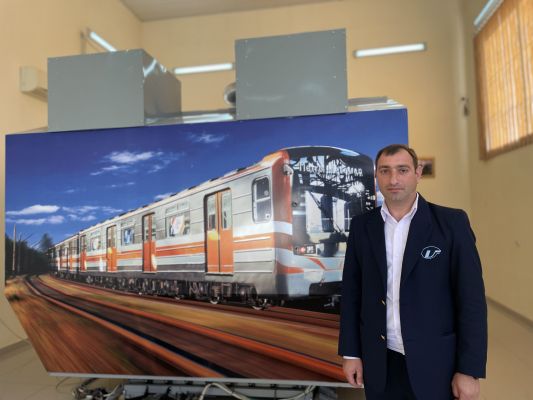The Yerevan Metro Reconstruction Project is Implemented with the EU Support: Explains Harutyun Yeranosyan, 3rd class engine driver

40-year-old Harutyun Yeranosyan has been a 3rd-class engine driver of the “DEPO” station of the Yerevan subway for three years. He loves his work because he has been connected to the Yerevan Metro since childhood. His father, who is now retired, also worked as a train driver. Despite being a radio technician by profession and having previously worked at the Metropolitan Communications Branch, Harutyun expresses no regrets about becoming a driver. “I thoroughly enjoy my work. Although it entails great responsibility and is quite difficult, it is also fascinating, says Harutyun.
While describing his daily life in the Yerevan Metro, Yeranosyan emphasizes that every aspect of his work is unique. He works two shifts and undergoes a medical examination every day before entering the cabin.
The driver is excited about the reforms in the Yerevan Metro. He highlights the significance of international donors’ support, particularly from the European Union.
Since 2010, the EU has been providing assistance for the reconstruction project of the Yerevan Metro. The first phase has already been completed, resulting in crucial improvements that have been made to address the immediate needs of the Yerevan Metro and to bring its infrastructure out of its emergency technical condition. In 2013, the financing agreement for the second phase of the Yerevan Metro reconstruction project was signed with the EBRD (European Bank for Reconstruction and Development), European Investment Bank, followed by an agreement with the EU H A (High-Level National Authorities) in 2014.
The second phase of the project ensures the overhaul of the Yerevan metro system. It will improve public health and safety concerns identified during the first round of technical audits, including water infiltration into subway tunnels, fire-fighting equipment, and occupational safety measures such as car wash equipment and driver training. As a result of these planned reforms providing better infrastructure, Yerevan residents’ quality of life will be significantly improved.
According to Yeranosyan, the driver training program is essential as it allows them to acquire skills to navigate in various emergencies and ensure passengers’ safety.

“After each shift, we come, register, and practice. We encounter all kinds of malfunctions and manage the situation by communicating with the dispatcher and instructing drivers on actions that need to be taken. Previously, when there was no training device, we were verbally informed and given instructions on how to respond in different situations. With the acquisition of the training device, the work process has changed; we feel more confident sitting at the wheel of the metro and doing our work”, explains Harutyun Yeranosyan.
The driver acknowledges that it is impossible not to notice the changes occurring in the Metro in recent years. The introduction of modern equipment has transformed the appearance of the Yerevan metro.
Fire-fighting equipment and rolling stock have been significantly restored, extending the service life of subway cars. The wagons are now regularly washed in a washing station equipped with a compact water recycling plant that cleans the water before it is discharged into the municipal sewer. All these developments contribute to a longer lifespan for the metro infrastructure and provide safer and more comfortable transportation services for passengers.
According to Harutyun Yeranosyan, these improvements generated greater interest among young people to work as train drivers.
“Young people are very interested now. We have assistants who are eager to become drivers. It is a unique profession. Once you experience riding the subway, you don’t want to do anything else. Being a driver is an unparalleled and exceptional profession,” concludes Harutyun Yeranosyan.